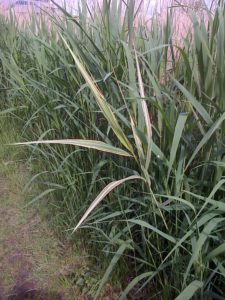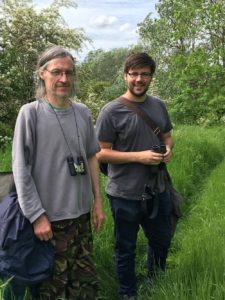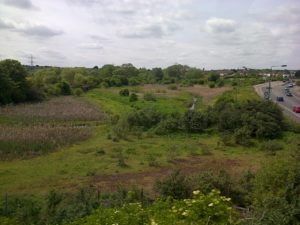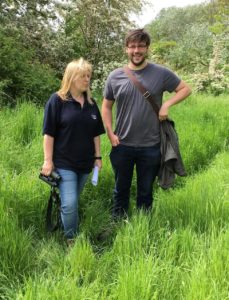David Courtneidge, Water for Wildlife Project Officer (South) for London Wildlife Trust came to Bexley on May 20th. He is visiting wetland sites across south London with a mission to select an initial three to focus on for training/recording and habitat improvement events, with a particular focus on Odonata.
He was welcomed at Crayford station by Thames Road Wetland Site manager Chris Rose. They then walked along the Cray to the wetland, where they were joined at the site by Assistant River Cray Project Officer Joanna Barton. It is early in the Dragonfly and Damselfly season, but Azure, Large Red and Banded Demoiselle Damselflies were seen, though the hoped-for Hairy Dragonfly was not in evidence (inevitably, one put in an appearance the day after ….) . Much other wildlife was seen, including low-flying Swifts, Common Lizards and a couple of Grass Snakes.
Chris and David then took the train round to Belvedere to visit Crossness Nature Reserve at Erith Marshes. A benefit of this particular journey is that a brief, but panoramic and otherwise inaccessible view of the wetland can be obtained, from the height of the railway embankment.
Whilst waiting for Reserve Manager Karen Sutton, prolonged views of a Kestrel hunting over one of the threatened Borax fields were enjoyed. Both the northern sector and Southern Marsh were traversed, and Azure, Common Blue and Blue-tailed damselflies were seen, along with a female Broad-bodied Chaser.
Chris spotted a variegated Common Reed shoot. A number of plants that are garden escapes were noted along the Belvedere Road footpath, including several Aquilegia in flower.

Variegated Common Reed (Phragmites australis) shoot at Crossness. There is already a variegated form in cultivation, so we won’t be making a fortune out of this ….. (Photo: Chris Rose)
If a Bexley site is selected, there are a number of reasons why Crossness would be likely to win out over others, including size, having the most Odonata species and a large Friends group to tap into.
The project is funded until 2019, so has a much better chance of leaving a lasting legacy than the far too many nature conservation schemes that only get the finance for a year or less. We hope to be seeing David in the area again soon.
Chris Rose



